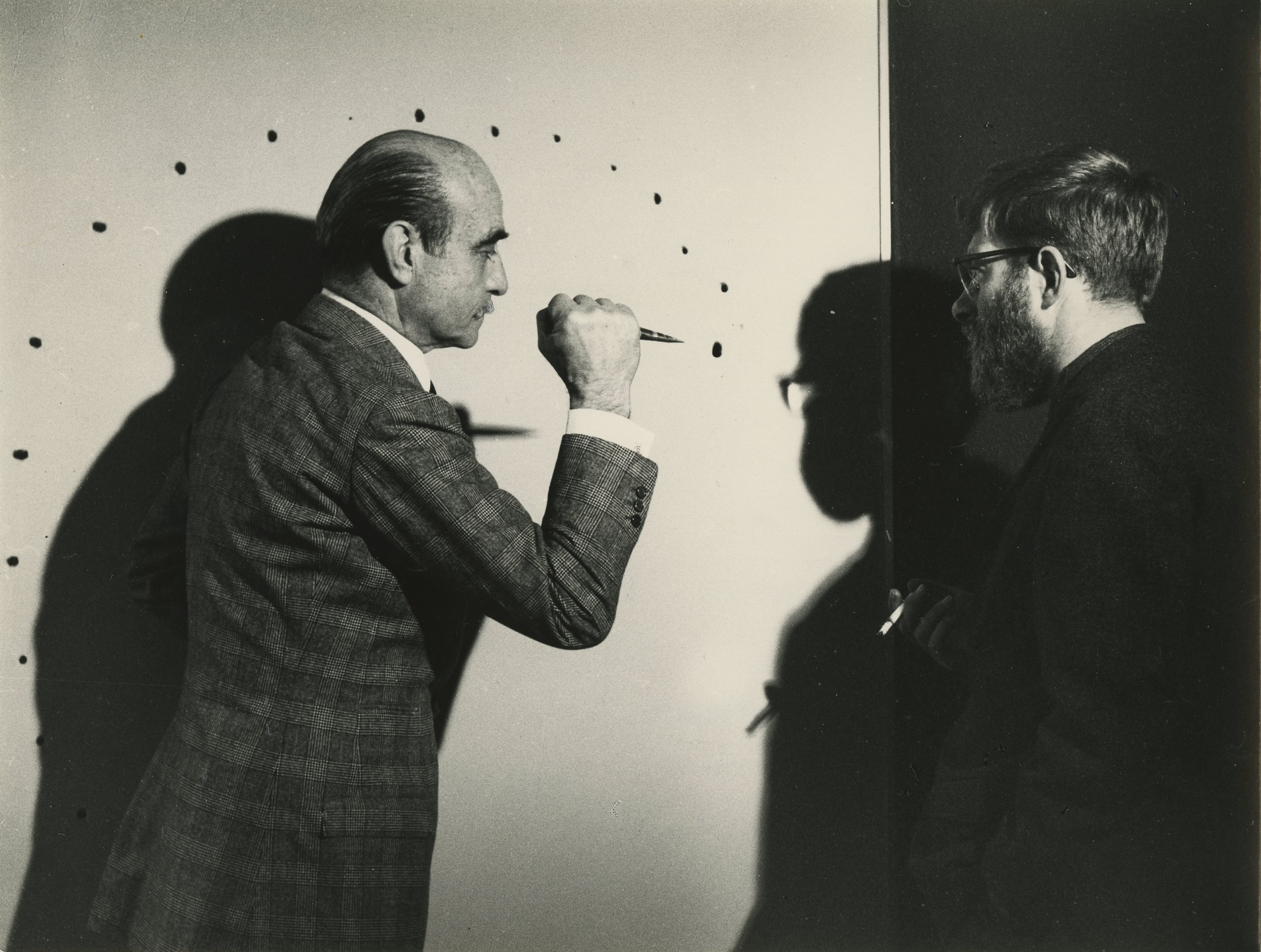
Lucio Fontana Concetto spaziale, Attese waterpaint on canvas 73 by 60.3 cm. executed in 1965
Lucio Fontana at The Met Breuer. Wednesday, February 13, 6:30 pm. Casa Italiana Zerilli-Marimò. 24 West 12th Street, New York, NY, 10011. A panel to discuss today's relevance of Lucio Fontana (1899-1968), on the occasion of the retrospective exhibition at The Met Breuer. An exhibition dedicated to Fontana and avant-guarde artists in 1950s.

Blog de casa faz milagres aqui Lucio Fontana na Tate Modern
Lucio Fontana: On the Threshold—the first retrospective of the Argentine-Italian artist in the United States in more than four decades—will reassess the legacy of this key postwar figure through a selection of exquisite sculptures, ceramics, paintings, drawings, and environments made between 1931 and 1968.The founder of Spatialism and one of the most innovative artists of the 20th century.
.jpg?mode=max)
LUCIO FONTANA (18991968)
Lucio Fontana 1899-1968 . T03961 Spatial Concept 49-50 B4 1949-50 . Punctured stretched canvas with seal coat 550 x 846 (21 5/8 x 33 5/16) Inscribed 'l. fontana | 1950' b.r., 'l. fontana "Concetto Spaziale" 1950' on back of canvas centre and 'Concetto Spaziale No.12' in another hand on back of stretcher Purchased from the Fondazione Lucio Fontana (Grant-in-Aid) with assistance from the.

Now Available Two Historic Lucio Fontana Retrospective Catalogs
Through April 14. In 1958, the Argentine-Italian artist Lucio Fontana (1899-1968) made what the Metropolitan Museum of Art calls "one of the most extraordinary, radical gestures in modern art.
.jpg?mode=max)
Lucio Fontana (18991968)
Lucio Fontana, biography. Lucio Fontana was born on February 19, 1899, in Rosario di Santa Fé, Argentina, to Italian emigrants from whom he would inherit a passion for art: his father Luigi was in fact a sculptor, specializing in funeral statuary, while his mother Lucia Bottino was a theater actress. The artist attended school in Italy; he was in elementary school in Biumo, at the Tasso.

7 Things you Need to Know about Lucio Fontana Contemporary Art Sotheby’s
Summary of Lucio Fontana. The career of artist Lucio Fontana spans some of the most tumultuous decades of the 20 th century, from the build up to World War I to the aftermath of World War II and the onset of the Cold War. Trained initially as a sculptor, Fontana rejected the traditional constraints of particular artistic materials and techniques, choosing instead to invent his own media and.

Lucio Fontana (19 February 1899 7 September 1968) was an Italian painter, sculptor and
Fontana's artistic contributions remind us to think outside the box, and to celebrate his birthday, we've compiled seven quotes, on space, change, and even God, to best remember him by. Lucio.

L’art de la lacération chez Lucio Fontana Barnie's Art Invest
Lucio Fontana (Italian: [ˈluːtʃo fonˈtaːna]; 19 February 1899 - 7 September 1968) was an Argentine-Italian painter, sculptor and theorist. He is mostly known as the founder of Spatialism. Early life. Born in Rosario, Santa Fe, Argentina, to Italian immigrant parents, he was the son of the sculptor Luigi Fontana (1865-1946).
.jpg?w=780)
Lucio Fontana A Primer Christie's
Spatial Concept, Waiting is one of a series of works Fontana made in Milan between 1958 and 1968. These works, which all consist of a canvas that has been cut either once or multiply, are collectively known as the Tagli ('cuts'). Considered together, they are Fontana's most extensive and varied group of works and they have come to be seen as emblematic of his gestural aesthetic.

These are the Highest Prices of Lucio Fontana Paintings Achieved in Auction Widewalls
Lucio Fontana (Italian: [ˈluːtʃo fonˈtaːna]; 19 February 1899 - 7 September 1968) was an Italian painter, sculptor and theorist of Argentine birth. He was mostly known as the founder of Spatialism .

Exhibitions in Paris The Story of Le Jour, a Lost Painting by Lucio Fontana Wanderarti
Lucio Fontana: Spatial Environment (1968) Through April 14 at El Museo del Barrio, Manhattan; 212- 831-7272, elmuseo.org. Holland Cotter is the co-chief art critic.

Pin on idaFONTANA idaDAVINCI idamariapan idealeconcepts idampan RAW ART LUCIO FONTANA
By ripping through his canvases, Lucio Fontana changed what a painting could be, and the course of art history. His groundbreaking slashed paintings, called Cuts (Tagli) embodied Spatialism, Fontana's art movement that was meant to create a new kind of art synthesizing color, sound, space, and movement.Before his Spatialist manifestos and slashed paintings, Fontana was a sculptor, and in a.

Lucio Fontana Autour d’un chefd’œuvre retrouvé Tornabuoni Art
A Life Between Two Worlds. Lucio Fontana was born in Argentina in 1899, to an Argentinian mother and an Italian father. He moved to Italy after his parents separated in 1905, and through his schooling, was exposed to the ideals of Futurism and new ways of creating art. He served as a second lieutenant in World War I, discharged with a silver medal after sustaining an arm injury.

Thinking images Lucio fontana, Typography quotes, Fontana
Lucio Fontana, Untitled, 1958 . Estimate $50,000-70,000. Contemporary Curated , New York, 1 March 2019. 2. Fontana didn't begin creating canvas-based art until he was in his 50s. Escaping the political turmoil of Europe, Fontana moved back to Argentina in 1921 and began making busts for his father's workshop, which specialised in making.

Lucio Fontana (18991968), Concetto spaziale, 1961. Alain.R.Truong
Lucio Fontana's minimalist modern art has delighted and confused critics since he started producing his infamous slashed canvases in the 1940s. One of his most celebrated works Spatial Concept: Waiting consists of a single cut on a warm, brown-hued canvas. As the father of the spatialism concept, Fontana was at the helm of important developments in the modern art movement.

Lucio Fontana Lucio fontana, Fontana, Contemporary modern art
Lucio Fontana was born in 1899 in Rosario de Santa Fé, Argentina to Italian parents. He spent the 1930s and 1940s in Italy and France, where he worked as a sculptor and organised his first exhibitions. Although he is mostly known for his painting series, Fontana trained initially as a sculptor. His background and education in sculpture.